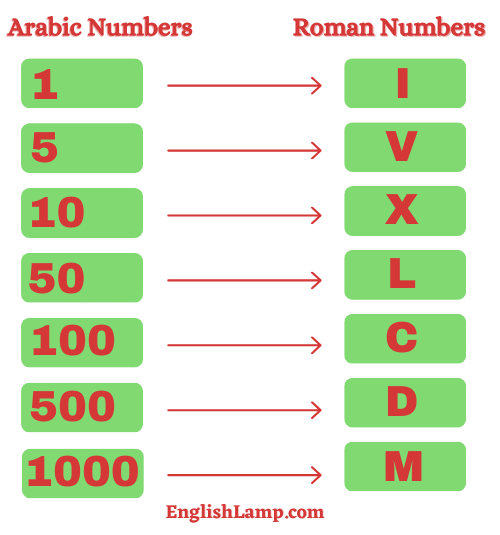The Latin alphabet is used to write Roman numbers. Roman numbers are written with a combination of letters, and each letter has a fixed value. It doesn’t have a place value.
Seven letters of the alphabet to show Roman numerals
Seven alphabet letters are used as seven symbols to make the Roman numerals. Those are I, V, X, L, C, D, and M. Those represent the different numbers.
The following chart shows the Roman numbers corresponding to the Arabic numbers.
Roman symbols are shown by the following seven letters of the alphabet:
| Sr. No. | 1 | 2 | 3 | 4 | 5 | 6 | 7 |
| Arabic numerals | 1 | 5 | 10 | 50 | 100 | 500 | 1000 |
| Roman numerals | I | V | X | L | C | D | M |
These seven letters are used to make thousands of numbers.
How to form Roman numerals
There are rules to form the Roman numerals.
- If a symbol is placed before a larger symbol, it is subtracted.
- Example: IXX = XX – I = 20 – 1 = 19
- If a symbol is placed after a larger symbol, it is added.
- Example: XXI = XX + I = 20 + 1 = 21
- We can’t use the same symbol more than three times in the Roman numeral.
- There is an exception for the number 4. 4 is written as IV, but we often see 4 as IIII on the face of clocks.
Do Roman numerals have zero?
There isn’t a symbol for zero. The ancient Romans didn’t need a zero. However, scholars started to use the letter N for nothing or nulla.
All symbols are added together. Every symbol in Roman numeral has the same value. For example, I is always 1, and L is always 50. Value changes according to its position in the number.
Use of Roman numerals
After the Roman Empire, Arabic numbers took their place in the 14th century. But Roman numerals are still used in some applications.
• Roman numbers are commonly used in year numerals on monuments, structures, tombstones, and other funerary inscriptions.
• Copyright dates at various locations.
• Names and titles
Roman numerals are often used in royal titles in history to differentiate from each other. It is shown when there is more than one ruler with the same name.
• Names of popes and monarchs
• Sequels to number the parts of a work
Roman numerals are used to differentiate the works when there is a sequel of any work. There may be seasons of web series, TV shows, series of a film, and plays, video games. A series of books may use Roman numerals.
• The year of production of television shows, web series, films, and other works of art within the work itself. The year of construction on buildings.
• Page numbering of introduction and prefaces of books.
• Recurring grand events
• Music theory
Roman symbols are helpful in music theory for organization and indicate triads.
• On the clock
Why IIII instead of IV is on the face of the clocks
We write the symbol IV for the number 4, but on the face of the clocks, we see IIII instead of IV. This is not a mistake. This is called a ‘watchmaker’s four’.
There are some theories of using IIII on clocks-
- The king of France, Charles V, had told a watchmaker to change IV to IIII. He believed IV as bad luck because we make IV by subtracting one from V.
- IIII was in use to show the number 4 when it was changed to IV until the 17th
- Watchmaker’s four may be used for aesthetic purposes and readability.
- IV and VI may easily confuse people.
Frequently asked questions
How do you read XXIX?
XXIX is a Roman numeral for the Arabic number 29. We read XXIX as 29.
What is XXIV in numbers?
How many is xxv?
Related topics-
